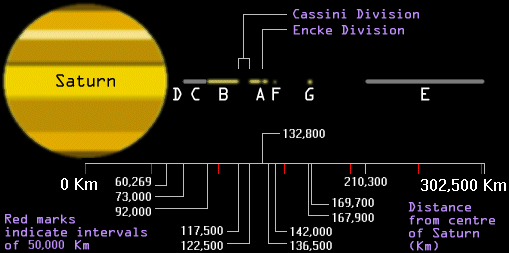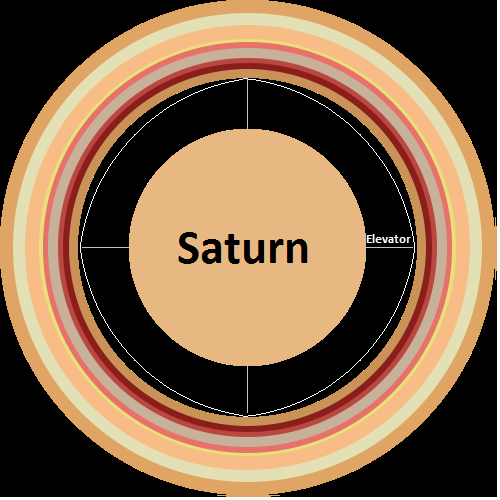New Mars Forums
You are not logged in.
- Topics: Active | Unanswered
Announcement
#1 2016-04-16 10:37:05
- Tom Kalbfus
- Banned
- Registered: 2006-08-16
- Posts: 4,401
Saturn Space elevators
I got an idea for a space elevator. How about one around Saturn? Saturn has a rotational period of 10.2336 hours, and the synchronous orbit for it is at a radius of 109,275 km, Saturn's equatorial radius is 60,268 km thus a space elevator around Saturn would be 49,007 km long. This puts synchronous orbit in the middle of Saturn's B ring. On Earth the distance is 35,786 km, or 29,386 km after subtracting Earth's radius. That means a Saturnian Space Elevator would be 19,621 km longer than an Earth Space elevator. Fortunately Saturn has rings, the closest ones are at 66,900 km from the center, the furthest ones are 480,000 km from the center. These rings could be used as construction materials for the Elevator and the rest can be used to support the weight of the elevator at various distances from Saturn, using an orbital Space Fountain concept, in other words transferring some of the momentum of the ring particles to the space elevator to support its weight. Helpfully, most of these ring particles all orbit in the same plane. The bottom portion of the elevator could dangle within Saturn's atmosphere. The elevator could be used to mine Saturn, and to get humans and other cargo into and out of Saturn's atmosphere without expending too much rocket propellant. Saturn's atmosphere would be valuable in a fusion economy, especially when it comes to obtaining that rare element Helium-3. Saturn is probably the most hospitable gas giant for humans, (although that isn't saying much) The gravity is about the same as Earth. (Varies with latitude due to Saturn's spin) Saturn could be said to be the warmest gas giant with Earth-normal gravity, but more importantly, it is closest to Earth, Uranus and Neptune are further away. Saturn's ring system could be used to help extract Helium-3 from Saturn's atmosphere. People could also live in Saturn's atmosphere either dangling at the end of a space elevator or by using hot hydrogen balloons to remain aloft.

Here is a diagram of Saturn and its rings.
Here is a map of Saturn's radiation belts. As you can see, the rings are in a relatively radiation free zone, the hazardous radiation belts are outside the ring system. I think that's in part because the rings stop charged particles, who's orbits intersect them, a ring particle, being largely made of ice, make an effective radiation shield, and since this radiation goes around in circles around Saturn, the rings prevent them from making a complete circle within the ring radius.
Here is the top down view of Saturn and its rings. Imagine if we could turn those rings into a space elevator(s). You probably need some nanotechnology or von-neuman machines to build space elevators out of these ring materials. The Elevator itself would take the form of a wall, sort of like a phonograph record. I think there is enough material here that a wall could be solidified out of this ring and the ring itself lowered down into Saturn's atmosphere. Then some transport mechanism would absorb the hydrogen from its atmosphere, and transport it up the to outer edge of the rings, where the hydrogen would be packaged and flung on an intercept orbit with Venus, where that hydrogen may be combined with the oxygen in Venus carbon-dioxide atmosphere to make oceans for that planet.
On a more modest scale:
As for getting into and out of Saturn's atmosphere, a space elevator would do this trick. Probably the first ones would need to hang onto a stream or ring particles that are moving at faster than orbital velocity, in order to support the tether. This would be located under the innermost ring of Saturn.
As you can see by this diagram, there are four space elevators, they don't extend out to synchronius orbit, rather they end before reaching the innermost ring of the giant planet, the ring particles are then used as part of a stream. At the tops of each elevator cable is a particle deflector which deflects the stream of particles towards the top of the next space elevator, which in this case is 90 degrees around the planet, and that space elevator deflects the stream towards the next elevator and so on. By this device, people can move up and down this elevator, into and out of Saturn's Atmosphere. Once out of Saturn's atmosphere, a traveler may be accelerated sideways along a cable so as to reach orbital velocity, and then it can climb the rings further out away from the planet, saving on rocket propellent.
Last edited by Tom Kalbfus (2016-04-16 10:41:32)
Offline
Like button can go here